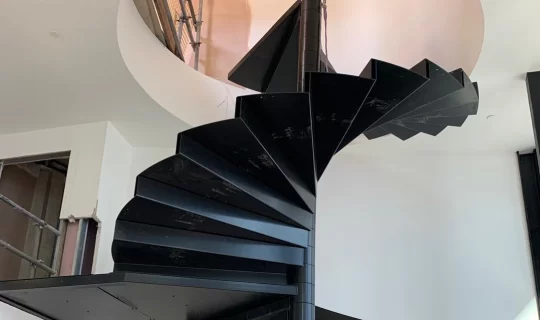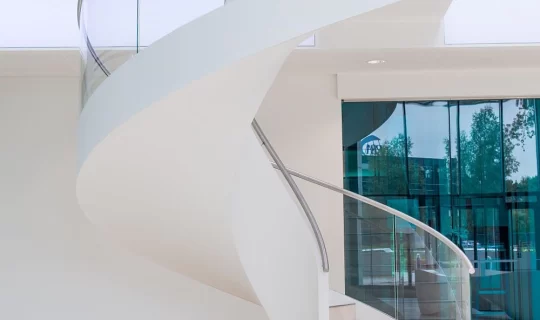A handy comparison guide for curved and spiral staircases
When you’re trying to decide on the right bespoke staircase for your project it can be quite intimidating to make a decision based on so many available options. Maybe you know that you want something with curves rather than angles, but don’t really know the difference between spiral and helical constructions – the technical terms used can be a little overwhelming, so we have made it simple with a handy comparison guide that should give you all the information you need to make the right choice for your property.
What are the key features of a spiral staircase?
Spiral staircases usually rotate around a central column and create a complete circle as they rise. They can spiral in either direction and be constructed from a variety of materials, with open or closed risers and a huge choice of balustrade designs.

Spiral stairs take up less floor space than other staircase types which is a big advantage in a property where space is at a premium, with the downside being that the smaller the circle, the steeper the stairs will need to be. A steeper gradient creates its own issues, such as being more difficult for people with reduced mobility to use, and making it tricky to maneuver furniture up and down! Another pro for spiral staircases is the relative ease of installation compared to other styles – because they can be freestanding and do not need to be fixed to a wall, they provide a little more versatility and tend to be cheaper than helical staircase designs.
What are the key features of a helical staircase?
Helical staircases are also referred to as curved staircases, because of the flowing shape of the stairs. Unlike spiral staircases, curved stairs do not revolve around a central column, which makes their radius wider and therefore easier to navigate but also means that more space is required for their installation. There are a variety of styles of curved staircases available, they can be either oval or elliptical, spine beam construction, and finished in a wide range of materials.

The two main disadvantages of a helical staircase are the need for more floor space, and the higher costs associated with the more complex bespoke design and creation. However this style of staircase is definitely one of the most luxurious, and is often the design of choice for high-end hotels and other luxury developments.
Making a decision: spiral vs helical
Both styles of staircase feature a curved or circular structure, which is aesthetically pleasing and creates a sense of drama and impact in any situation. They can both be constructed and finished in a great variety of materials to suit any interior, and built to custom requirements in order to fit the specific needs of a space. There are of course strict regulations for both options which need to be adhered to, but with expertise it should be possible to craft exactly the staircase you desire within the parameters needed. Check out our inspiration galleries or social media channels for lots of examples of both staircase types and the variety of ways that they can be used.
To summarise, if you aren’t short on space and have a healthy budget, and want to inject some serious drama into your interior, you can’t go wrong with a stunning curved staircase. If space is a consideration and you don’t have concerns about accessibility, but still want a visually striking result, then spiral is probably the solution for you! If you’re still struggling to a conclusion and need some expert advice, you can contact our friendly team who will be happy to discuss possibilities with you.